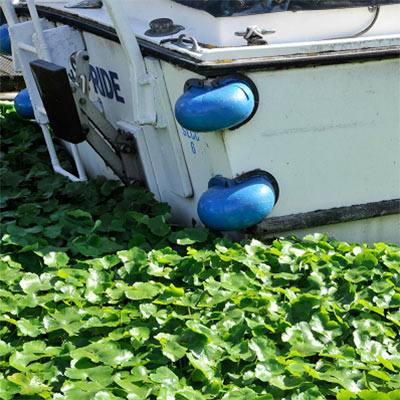Non-Native Invasive Species
Advice on preventing the spread of non-native invasive species




What are non-native invasive species?
Non-native species are characterised as any wild species introduced to an area outside of their natural habitat. While some non-native species are completely harmless, others can cause damage to the environment, economy, and way we live. These are known as non-native invasive species.
How do invasive species spread?
Non-native invasive species can be transported via shipping vessels, aquaculture industries, accidental or intentional release and even by ocean currents. They can also be relocated by hitching a ride on boat hulls, anchors, and propellers or being carried in ballast and bilge water.
What's the problem?
Invasive species can spread disease, restrict navigation, clog up propellers and add significantly to the management costs of our waterways. Recreational facilities can also suffer as a result.
Once established, invasive species become extremely difficult and expensive to eradicate. Fast-growing species like Zebra Mussels can cause problems by blocking engine cooling water intakes. This results in engines over-heating.
Other invasive species, such as Carpet Sea Squirt have a smothering effect. They cover aquatic habitats in thick sheet-like growths and interfere with fishery and aquaculture operations.
How to prevent the spread?
The best way to protect your stretch of water and others around the UK from invasive species is to follow the Check, Clean, Dry approach.
Check your boat, equipment, and clothing for living plants and animals. Pay particular attention to areas that are damp or hard to inspect.
Clean and wash all equipment thoroughly with fresh water and antifoul boats annually. Remove visible fouling and put it in the bin, not back in the water.
Dry responsibly! When recovering a boat, trailer, dinghy, personal watercraft, or RIB, drain water from every part and all equipment that can hold water before leaving the site. Clothing and equipment should be thoroughly dried for as long as possible.
Discover more RYA biosecurity guidance for RIBs, sports boats, and outboard engines. For further advice and information on preventing the spread of invasive species visit The Green Blue
What are the RYA and UK Government doing to help?
The GB Non-Native Species Secretariat has responsibility for helping to coordinate the approach to non-native invasive species in Great Britain. Their work is underpinned by a strategic framework within which Government departments, their related bodies, and key stakeholders coordinate. The RYA has contributed through our work in raising awareness of biosecurity with our members and The Green Blue.
New EU Regulation on Invasive Alien Species (IAS) came into force on 01 January 2015. The legislation was implemented to address the problem of IAS across Europe through prevention, early warning, rapid response, and management.
Using risk assessments and scientific evidence, a list of concerning IAS was drawn up with the Member States in 2016 (since updated). Member States are required to address these species by preventing them from being introduced, kept, sold, transported, reproduced, or released. Member States will also have to put in place appropriate measures to tackle new invasions or established populations of the listed species. The regulation also establishes a surveillance system for early detection and measures for rapid eradication.
The RYA has worked closely with the European Commission and the UK Government to minimise the impact of IAS regulation on recreational boaters, ensuring that any restrictions have been proportionate, evidence based and enforceable.
The Council of Europe commissioned the RYA to develop a European Code of Practice on Recreational Boating and Invasive Alien Species to ensure that we are playing our part to stop the spread across Europe. This was adopted by the Bern Convention in November 2016.
Further information
For resources, tips, and guides on increasing your club’s biosecurity and what to do if you spot an invasive species, visit The Green Blue
Identifying non-native species isn’t easy, but online guides from the Great Britain Non-Native Species Secretariat are available to help.
The European Environment Agency has also carried out two in depth reports on the impact of invasive species on biodiversity.
